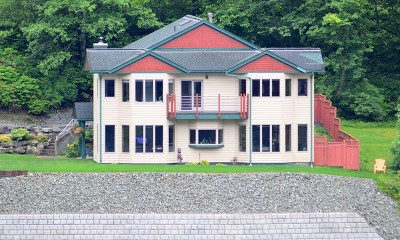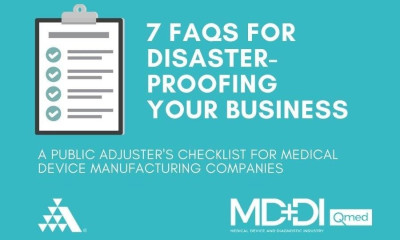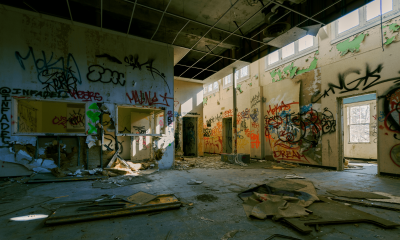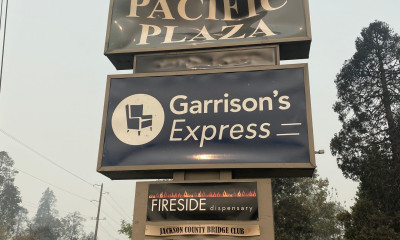A Private Adjuster's Perspective: The Perfect Storm

The sun had just risen, casting a deep, red pall over everything. As he looked around his domain - a small boat marina named “Marina del Sol”--the Harbormaster wore an expression of concern as he reflected upon the age-old adage of seasoned mariners: red sky at night, sailor’s delight; red sky in the morning, sailor’s warning.
The old salt had reason to be worried. As the minutes passed, the winds increased, beginning to howl. The sky darkened with billowing, grey-black clouds and one could begin to feel precipitation in the air.
Within an hour, tragedy struck. Hurricane-strength winds and waves of epic size battered the marina. Berthed vessels were cast ashore as if they were driftwood; buildings tumbled.
Fortunately, the docks, piers, and pilings where the boats once resided were left relatively intact-- suffering only minor damage.
Unfortunately, a large free-standing rock and concrete structure that had stood guard at the harbor entrance, allowing boats to freely enter and exit from different directions was damaged beyond recognition. As a result of its destruction, the waves and sea now entered the harbor with impunity.
The owners of the marina - used to Atlantic storms - had the foresight to obtain coverage for hurricanes, windstorms, and other natural disasters common to the area. However, they had not had the foresight to obtain a policy specifically tailored to a marina. The policy they had procured was a general-purpose commercial policy and, like most commercial policies in play today, contained numerous items of property designated as “not covered.”
These owners also had the good sense to engage the services of The Greenspan Co./Adjusters International to assist them in the quantification and qualification of their property damage, business interruption, and extra expense insurance claims, as well as to aid in negotiating for coverage where coverage would be an issue.
After sifting through the rubble and preparing a game plan for the filing of insurance claims for the clearly compensable losses, the attention of the team at The Greenspan Co./Adjusters International was quickly drawn to the rather painful question:
Was the multi-million-dollar free-standing structure standing guard to the harbor entrance an item of “non-covered” property under Marina del Sol’s policy of insurance?
Based upon almost 78 years of representing only insureds, the answer was quite obvious: it depends. On what does it depend? Again, the answer was quite obvious: it depends on the actual language of the marina policy.
But aren’t all commercial policies the same? Hereto, the answer is readily apparent: NO!
Let’s look at a few and observe the differences. Later, we will apply them to the factual situation at hand and see the resulting differences.
Example 1:
2. Property Not Covered
Covered Property does not include: …
- Bulkheads, pilings, piers, wharves or docks; …
- Retaining walls that are not part of a building….”
(ISO Form CP 00 10 10 12)
Example 2:
3. Property and Costs Not Covered
Unless the following property is added by endorsement to this Coverage Form, Covered Property does not include: …
- Bulkheads, pilings, piers, wharves, docks, dikes or dams…
(Company A Form DX T1 00 03 98)
Example 3:
C. PROPERTY AND COSTS NOT COVERED
Unless the following property or costs are added by endorsement to this Coverage Form, Covered Property and Covered Costs and Expenses do not include: …
- Bulkheads, pilings, piers, wharves, docks, dikes, dams, canals, sea walls or vehicular bridges; ….”
(Company B Form KTJ-CMB-296T453-A-09; emphasis mine)
Example 4:
Property Not Covered We do not cover loss to:…
- Bulkheads, pilings, piers, wharves, docks, seawalls or jetties….”
(Company C Form PK 10 04 07 09; emphasis mine).
Turning back to our initial question:
Was the multi-million dollar, free-standing structure covered under the marina’s policy?
The answer still remained a resounding: “IT DEPENDS”!
It depended on which policy form was in play at the time of the loss and whether Greenspan/Adjusters International's argument for coverage would prevail.
It is clear that, when one is interpreting and applying a policy provision, words are to be given their plain, ordinary and generally-accepted meanings unless definitively defined within the body of the insurance contract.
Ignoring for the moment which policy was actually in play, what would be the policy words of concern to Greenspan and the carrier and what are some common meanings associated with them?
Bulkhead: a retaining wall along a waterfront.
Piling: a long, slender column, usually of timber, steel or reinforced concrete, driven into the ground to support a load.
Pier: a structure extending into navigable waters for use as a landing place or promenade or to protect a harbor.
Wharf: a structure built along or at an angle from the shore of navigable waters so that ships may lay alongside to receive and discharge cargo and passengers.
Dock: the waterway extending between two piers for the reception of ships.
Jetties: structures extended into a sea, lake or river to influence the current or tide or to protect a harbor; protecting frames of piers; landing wharves.
Seawall: an embankment to protect the shore from erosion or to act as a breakwater.
At this point, a couple of more common definitions are needed in order to fully understand how the Greenspan team was able to effectuate, on the marina’s behalf, full coverage for the “structure.”
Retaining wall: a wall constructed to hold back earth.
Embankment: a raised structure to hold back water.
A few days later, after the storm had passed and fair weather had returned, Greenspan personnel and the carrier representative met on site to survey the damage and begin their discussions of amount of loss and coverages.
Both parties had in hand a copy of the actual policy. It was the ISO Form CP 00 10 10 12.
After taking time to review the coverages and limitations, the “war of words” began. The carrier’s adjuster leveled his opening “salvo:” there is no coverage for the guardian structure at the harbor entrance.
Asked to explain this rather abrupt and unequivocal denial of coverage, the adjuster responded that the structure was “property not covered” in that it fit the common definition of either a bulkhead, retaining wall, or pier - all structures designed and built to protect a harbor.
Greenspan/Adjusters International's adjusters vehemently disagreed and argued that the structure more readily and properly fit the definition of a seawall or breakwater and since neither breakwater nor seawall were scheduled as an item of property not covered, under common rules of interpretation, the insured must prevail.
To bolster its point, the team at Greenspan/Adjusters International directed the adjuster’s attention to various publications dealing with marine structures. First, reference was made to one by Gibson Marine Construction (Protect Your Waterfront Property by Building a Marine Construction Structure,2018) which noted the differences between various marine structures.
Most marine construction structures are built to prevent damage to shoreline or waterfront property. The four most common marine construction structures are:
- Retaining Walls
- Bulkheads
- Seawalls
- Revetments
Although the names of the most common types of marine construction structures are often used interchangeably, they are all actually a little different.
…a retaining wall (is) a relatively rigid wall used to support soil mass laterally so that the soil can be retained at different levels on two sides. The primary function of a retaining wall is to prevent land movement, such as sliding.
…a bulkhead is very similar to a retaining wall as they have the same functionality. The primary difference between the two comes down to what element is being retained on each side of the wall. A retaining wall has (earth) on both sides of the wall, whereas a bulkhead retains earth on one side of the wall and has water on the other side.
Next, the adjuster was asked, by the Greenspan team, to note the purpose and function of seawalls and breakwaters.
As Greenspan adjusters explained and pictorially demonstrated, a seawall is a raised structure designed to hold back or separate water to prevent flooding, the eroding of the coastline and/or waves pummeling a harbor and its floating residents. A seawall may be either free-standing (as was the marina’s guardian structure), with water on both sides, or built along the shoreline with earth on one side and water on the other.
Further and with even more emphasis, Greenspan/Adjusters International pointed the adjuster to pictures and definitions of a breakwater.
Breakwater: an offshore shore-parallel embankment that breaks waves, thereby reducing the wave energy reaching the harbor.
After much discussion, it became quite obvious and was ultimately agreed between Greenspan/Adjusters International and the carrier’s adjuster that the Marina del Sol’s structure at issue was either a seawall or breakwater.
Attention was then redirected to the actual policy in play.
The Greenspan Co./Adjusters International showed the adjuster that the “property not covered” section of the ISO Form did not list seawalls or breakwaters as excluded items. The adjuster was also shown copies of the policies issued by Companies B and C where seawalls and sea walls were clearly delineated as excluded items. Finally, Greenspan/Adjusters International argued that, if the carrier wanted to exclude seawalls or breakwaters, it could have easily done so - as the other companies had done.
The Greenspan/Adjusters International team ultimately won the day and “war of words,” obtaining a multi-million dollar recovery for the damaged seawall/breakwater.
Had Marina del Sol been insured under Company B or C’s policy, this story might have ended on a different note; although Greenspan would have vociferously and aggressively pressed the argument that a seawall and a breakwater are quite different structures.
Final Points:
- The whole issue could have been moot, had Marina del Sol, prior to the loss, asked for and procured a policy of insurance specifically designed to cover marinas.
- The whole issue could also have been rendered moot had Marina del Sol, prior to the loss, asked for and procured an endorsement adding coverage for all the items - including the breakwater - which was excluded under the “property not covered” section of the ISO Form.
- Policies of insurance should be carefully read and understood both before and after a loss by insureds and any questions presented to professionals such as The Greenspan Co./Adjusters International who deal, on a daily basis, with questions of insurance and coverage.













